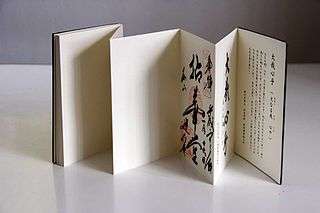Orihon
Orihon (OR-ee-hon, 折本 in kanji or おりほん in hiragana) is a book style originating from the Tang dynasty (A.D. 618-908) in China and was later developed in the Heian period (A.D. 794-1185) in Japan.[1]
History

The development of orihon began in China but later took on an association with Japanese books, as shown by its current name. "The development of alternatives to the roll in China is difficult to date, but it appears that at some time during the Tang period long rolls consisting of sheets of paper pasted together began to be folded alternately one way and the other to produce an effect like a concertina. It has been supposed that this form was suggested by the palm-leaf books which transmitted Buddhist texts from India to China. However that may be, it is in any case a fact that the concertina form was primarily used in China, and subsequently in Japan, for Buddhist texts. Books of this format are called orihon 折本 in Japan, and the format survived until the nineteenth century and beyond for printed Buddhist sūtras and occasionally for other books, such as reference lists, calendars, and folding maps."[2] Laura C. Liberman notes in an article that the accordion book style used in Tibet traces back to orihon origins.[3]
Etymology
The combination of characters are borrowed from Chinese, which originally translates the phrase to "a loss" or "a loss of money." [4] However, when looking at the individual characters, a different meaning is found. The Traditional Chinese characters are defined as 折 meaning "to break (e.g. stick or bone); a loss"[5] and 本 meaning "roots or stems of plants; origin; source; this; the current; root; foundation; basis; classifier for books, periodicals, files etc originally,"[6] In this context, it means a breakdown of a book. In Japanese, it combines the roots "ori" (fold) and "hon" (book).[7] Edith Diehl describes orihon as a general Asian style and translates it to "stabbed binding."[8]
Uses
Cyril James Humphries Davenport notes in his 1898 lecture that "writing upon a roll was found to be the most convenient at a very early date by the Chinese, Japanese and [K]oreans, they were also the first to find out that if the rolls were simply folded backwards and forwards between the "pages" of writing or printing, the whole book became easier to read, and this form, known as "Orihon," is used in those countries to the present day."[9]
Traditional orihon books are associated with Japanese Buddhist works and e-hon, or picture books. Modern applications are found in artistic modes, such as Tom Burtonwood's 2013 plastic rendering using a 3-D printer.[10]
Construction

Orihon consist of a long strip of paper that is written on one side and then compacted by folding in zig-zag fashion. The orihon format is considered a step between a scroll and a codex.
The style of folding is similar to that of the air bellows of a concertina or accordion, such that every written page faces another written page when the book is closed. It may therefore be opened to any page.[11] It may have a cover attached to the front and back end sections of the book. Diehl describes orihon as having stabbed holes in the back cover to allow the book to be "laced."[12]
List of Orihon Works
The Museum of Metropolitan Art in New York, New York hosts a collection of orihon art. Some of that work is available to view on their website. [13]
- Utagawa Hiroshige (Japanese, 1797-1858) Sakkyo Kageboshi Zukushi (Collection of Improvised Silhouette Plays) n.d.
- Onna Kasen, an 18th-century book written about famous Japanese female poets.[14]
- 中山聘使畧 (Chūzan heishi ryaku or Short account of the Ryūkyūan mission) This book explains the history and geography of Ryūkyū.[15]
- Suzuki Harunobu (ca. 1724-70). A beauty watching a couple drinking sake, from the The Spell of Amorous Love (Enshoku koi no urakata). Japan, circa 1766-70. Woodblock printed chuban orihon (folded illustrated book). 7.5 x 5.125 inches (19.2 x 13 cm). This piece is part of Asia Week New York's 2015 "gallery roster" for the "celebration for Asian Art" and is provided by Scholten Japanese Art from the United States as part of their exhibition Erotic Art of Japan: Everybody’s Doing It.[16]
References
- ↑ Binding Beauty: Conserving a Collection of Japanese Printed Books Barbara Korbel and Janice Katz Art Institute of Chicago Museum Studies Vol. 31, No. 2, Conservation at the Art Institute of Chicago (2005), pp. 16-23+105
- ↑ The Book in Japan: A Cultural History from the Beginnings to the Nineteenth Century by Peter Kornicki, p. 43. Retrieved from http://www.printsofjapan.com/Index_Glossary_O_thru_Ri.htm
- ↑ <Lieberman, Laura C. "The Robert C. Williams American Museum of Papermaking." JAB: The Journal of Artist's Books 15 (2001): 12-13. ProQuest. Web. 11 Mar. 2015.
- ↑ "Chinese Word - 折本".
- ↑ "Meaning of 折".
- ↑ "Meaning of 本".
- ↑ http://www.wordsense.eu/本/
- ↑ Diehl, Edith. "Primative Records and Ancient Book Forms." Bookbinding; Its Background and Technique. New York: Rinehart &, 1946. 12. Print.
- ↑ Davenport, Cyril. "Lecture 1." Cantor Lectures on Decorative Bookbinding. London: Printed by William Trounce, 10, Gough Square, Fleet Street, E.C., 1898. 2. Print.
- ↑ http://tomburtonwood.com/portfolio-item/orihon-3d-printed-book/
- ↑ https://art2551.files.wordpress.com/2011/10/book_demo.pdf
- ↑ Diehl, Edith. "Primative Records and Ancient Book Forms." Bookbinding; Its Background and Technique. New York: Rinehart &, 1946. 12. Print.
- ↑ "Metropolitan Museum of Art Orihon Collection".
- ↑ http://www.raco.cat/index.php/Datatextil/article/viewFile/274608/362870
- ↑ http://okinawa-repo.lib.u-ryukyu.ac.jp:8080/handle/okinawa/12729
- ↑ https://alaintruong2014.wordpress.com/tag/china-tibet/